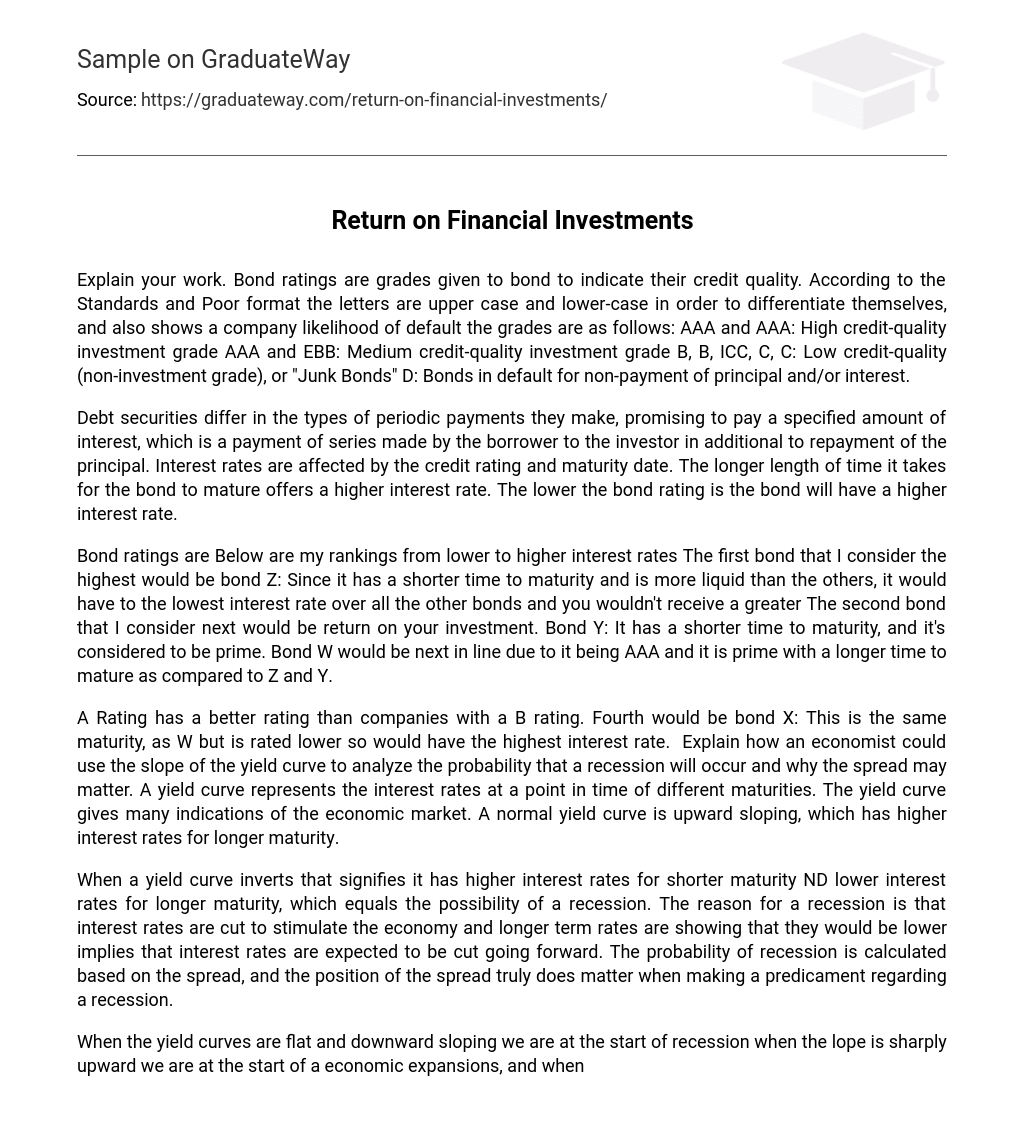Explain your work. Bond ratings are grades given to bond to indicate their credit quality. According to the Standards and Poor format the letters are upper case and lower-case in order to differentiate themselves, and also shows a company likelihood of default the grades are as follows: AAA and AAA: High credit-quality investment grade AAA and EBB: Medium credit-quality investment grade B, B, ICC, C, C: Low credit-quality (non-investment grade), or “Junk Bonds” D: Bonds in default for non-payment of principal and/or interest.
Debt securities differ in the types of periodic payments they make, promising to pay a specified amount of interest, which is a payment of series made by the borrower to the investor in additional to repayment of the principal. Interest rates are affected by the credit rating and maturity date. The longer length of time it takes for the bond to mature offers a higher interest rate. The lower the bond rating is the bond will have a higher interest rate.
Bond ratings are Below are my rankings from lower to higher interest rates The first bond that I consider the highest would be bond Z: Since it has a shorter time to maturity and is more liquid than the others, it would have to the lowest interest rate over all the other bonds and you wouldn’t receive a greater The second bond that I consider next would be return on your investment. Bond Y: It has a shorter time to maturity, and it’s considered to be prime. Bond W would be next in line due to it being AAA and it is prime with a longer time to mature as compared to Z and Y.
A Rating has a better rating than companies with a B rating. Fourth would be bond X: This is the same maturity, as W but is rated lower so would have the highest interest rate. Explain how an economist could use the slope of the yield curve to analyze the probability that a recession will occur and why the spread may matter. A yield curve represents the interest rates at a point in time of different maturities. The yield curve gives many indications of the economic market. A normal yield curve is upward sloping, which has higher interest rates for longer maturity.
When a yield curve inverts that signifies it has higher interest rates for shorter maturity ND lower interest rates for longer maturity, which equals the possibility of a recession. The reason for a recession is that interest rates are cut to stimulate the economy and longer term rates are showing that they would be lower implies that interest rates are expected to be cut going forward. The probability of recession is calculated based on the spread, and the position of the spread truly does matter when making a predicament regarding a recession.
When the yield curves are flat and downward sloping we are at the start of recession when the lope is sharply upward we are at the start of a economic expansions, and when the slop is somewhat upward we are in the middle of a an economic expansion. The position of the curves play a valuable role in determining which position we are in, in regards to a recession it can show where we have been down, steady, lacking and up and it shows the indicators of potential negative outputs. One year ago, you bought a bond for $10,000.
You received interest of $400 at the end of the year, as well as your $10,000 principal. If the inflation rate over the sat year was five percent, calculate the real return. Show your work. $10,000 x 0. 04 = $400 of interest at the end of the year = $10,400 return on investment $10,ox. 05 = $500 of interest at the end of the year = $10,500 return on investment . Suppose that the price of a stock is $50 at the beginning of a year and $53 at the end of the year, and it pays a dividend of $2 during the year. Calculate the stock’s current yield, capital-gains yield, and the return. Show your work for three separate calculations.
Current yield = income/initial value $50 x $2 $100 (Beginning of year) 53 x $2 $106 (End of year) $50/100-0. 5 $53/106 -0. 5 0. 5 x 100% = 50 % current yield 0. Xx% = 50 % current yield Capital gains yield = final value -initial value $106 – $100 = $6. 00 $6. 00/$100 = 0. 06 0. 06 = 0. 06 x 100% = Return = current yield + capital-gains yield 0. 5+0. 06-56 % Formulas found on page 26-27 of our textbook. Use the capital-asset pricing model to predict the returns next year of the following stocks, if you expect the return to holding stocks to be 12 percent on average, and the interest rate on three-month T-bills will be two percent.
Calculate a stock with a beta of -0. , 0. 7, and 1. 6. Show your work for three separate calculations. Capital-Asset Pricing Model = Rite = art + џi (Art – art) + Tie The capital asset pricing model (CAMP) is a model of stock prices that explains the returns to a stock as depending on how risky the stock is compared with the market average (Crouches, 2010. Peg. 144). Returns on different stocks react differently to changes in the markers excess return, so the coefficient џi differs across stocks. The CAMP suggest that the return to a stock above the risk-free interest rate has two sources of risk: systematic and unsystematic.





